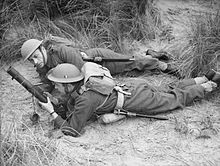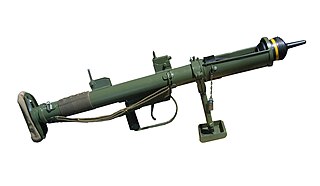
The Projector, Infantry, Anti Tank (PIAT) Mk I was a British man-portable anti-tank weapon developed during the Second World War. The PIAT was designed in 1942 in response to the British Army's need for a more effective infantry anti-tank weapon and entered service in 1943.

A mortar is usually a simple, lightweight, man-portable, muzzle-loaded weapon, consisting of a smooth-bore metal tube fixed to a base plate with a lightweight bipod mount and a sight. Mortars launch explosive shells in high-arching ballistic trajectories. Mortars are typically used as indirect fire weapons for close fire support with a variety of ammunition.

The Ordnance QF 25-pounder, or more simply 25-pounder or 25-pdr, with a calibre of 3.45 inches (87.6 mm), was a piece of field artillery used by British and Commonwealth forces in the Second World War. It was often described as being durable, easy to operate and versatile. It was the major British field gun and howitzer during the War.

The Type 89 grenade discharger, inaccurately and colloquially known as a knee mortar by Allied forces, is a Japanese grenade launcher or light mortar that was widely used in the Pacific Theater of World War II. It got the nickname the "knee mortar" because of an erroneous Allied belief that these launchers could be fired by propping its plate against the leg. However, anyone trying to fire it this way would receive a severe bruise from its hefty recoil.
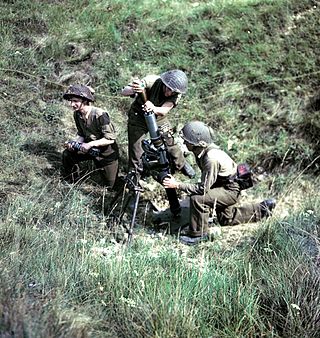
The Ordnance ML 3-inch mortar was the United Kingdom's standard mortar used by the British Army from the early 1930s to the late 1960s, superseding the Stokes mortar. Initially handicapped by its short range compared to similar Second World War mortars, improvements of the propellant charges enabled it to be used with great satisfaction by various armies of the British Empire and of the Commonwealth.

The 76 mm gun M1 was an American World War II–era tank gun developed by the U.S United States Ordnance Department in 1942 to supplement the 75 mm gun on the basic Medium tank M4. It was also used to arm the M18 Hellcat tank destroyer.

The M2 mortar is a 60 millimeter smoothbore, muzzle-loading, high-angle-of-fire weapon used by U.S. forces in World War II, the Korean War, and the Vietnam War for light infantry support.
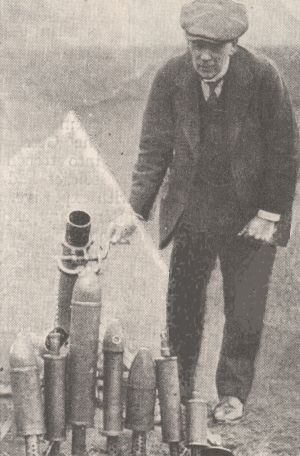
The Stokes mortar was a British trench mortar designed by Sir Wilfred Stokes KBE that was issued to the British and U.S. armies, as well as the Portuguese Expeditionary Corps, during the latter half of the First World War. The 3-inch trench mortar is a smooth-bore, muzzle-loading weapon for high angles of fire. Although it is called a 3-inch mortar, its bore is actually 3.2 inches or 81 mm.

The 8 cm Granatwerfer 34 was the standard German infantry mortar throughout World War II. It was noted for its accuracy and rapid rate of fire.

The M2 4.2-inch mortar was a U.S. rifled 4.2-inch (107 mm) mortar used during the Second World War, the Korean War, and the Vietnam War. It entered service in 1943. It was nicknamed the "Goon Gun" or the "Four-Deuce". In 1951 it began to be phased out in favor of the M30 mortar of the same caliber.
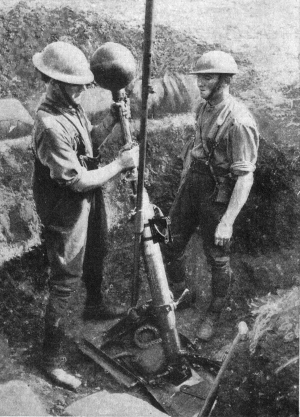
The 2 inch medium trench mortar, also known as the 2-inch howitzer, and nicknamed the "toffee apple" or "plum pudding" mortar, was a British smooth bore muzzle loading (SBML) medium trench mortar in use in World War I from mid-1915 to mid-1917. The designation "2-inch" refers to the mortar barrel, into which only the 22 in (560 mm) bomb shaft but not the bomb itself was inserted; the spherical bomb itself was actually 9 in (230 mm) in diameter and weighed 42 lb (19 kg), hence this weapon is more comparable to a standard mortar of approximately 5–6 in (130–150 mm) bore.

The 240 mm trench mortar, or Mortier de 240 mm, was a large calibre mortar of World War I. An original French design, it was developed by Batignolles Company of Paris and introduced in 1915.

The Brandt mle 27/31 mortar was a regulation weapon of the French army during the Second World War. Designed by Edgar Brandt, it was a refinement of the Stokes mortar. The Brandt mortar was highly influential, being licensed built or copied by numerous countries.

Ordnance QF 3 inch howitzer was a howitzer fitted to British cruiser and infantry type tanks of the Second World War so they could fire a smoke shell in "close support" of other tanks or infantry. HE shells were also available.

The Ordnance ML 4.2-inch mortar was a heavy mortar used by the British Army during and after World War II.

The M6 Mortar is a 60 mm lightweight infantry mortar made by Hirtenberger AG of Austria.

The M-4 commando mortar, also known as a patrol mortar, is a lightweight 60 mm commando mortar manufactured by Denel Land Systems.

The Ordnance QF 95-mm howitzer was a British howitzer built in two versions during the Second World War. The tank howitzer version was accepted for service use, but the infantry version was not.

The L16 81mm mortar is a British and Canadian standard mortar used by the Canadian Army, British Army, and many other armed forces. It originated as a joint design by the UK and Canada. The version produced and used by Australia is named the F2 81mm Mortar; that used by the U.S. armed forces is known as the M252.

